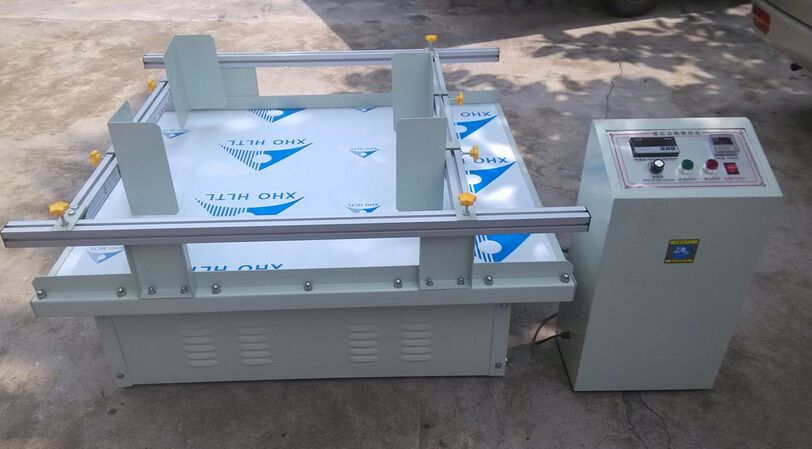ISO 13355-8 Random Vibration for Rigid Packages
The ISO 13355 series of standards is designed to provide guidelines for simulating the dynamic environments that packages encounter during transport, including random vibration testing. This specific standard, ISO 13355-8: Rigid Packages – Random Vibration Testing, focuses on rigid packaging materials and their ability to withstand the stresses associated with transportation.
Rigorous testing is essential for ensuring that packaging can protect products from damage during transit. ISO 13355-8 specifies the procedures for conducting random vibration tests, which are critical in assessing the durability of packages under conditions that mimic real-world transport scenarios. The test aims to determine whether a package will maintain its integrity and function effectively after exposure to vibration.
The testing methodology involves subjecting the packaged product to controlled levels of random vibration, typically within specified frequency ranges and acceleration limits. This approach ensures that the packaging is subjected to realistic environmental conditions without simulating every possible transport scenario. The objective is to identify potential weaknesses in the design or materials used for packaging so that improvements can be made before products are shipped.
To conduct ISO 13355-8 testing, it's crucial to follow strict procedures outlined by this international standard. This includes preparing the specimen according to specified dimensions and ensuring that all components of the package meet the necessary requirements before being subjected to vibration forces. The test setup must also comply with the guidelines provided in the standard.
During the test, a random vibration signal is applied to the package using shaker tables or other suitable equipment capable of generating controlled frequency bands and peak accelerations. Specimens are monitored closely throughout the process to ensure that they remain intact and do not exhibit any signs of damage or failure.
The results from these tests provide valuable insights into how well a particular packaging design can withstand the rigors of transport. By identifying vulnerabilities early in the development stage, companies can make informed decisions about modifying designs if needed. Additionally, compliance with ISO 13355-8 helps manufacturers meet regulatory requirements and build confidence among consumers regarding product safety.
For those responsible for quality assurance or supply chain management within organizations operating internationally, ensuring adherence to such standards like ISO 13355-8 is vital. It demonstrates commitment to maintaining high standards of manufacturing practices while also providing peace of mind that products will arrive safely at their destination.
Industry Applications
| Industry Sector | Common Products |
|---|---|
| Aerospace | Mission-critical electronics, fuel containers |
| Automotive | Electronic components, automotive interiors |
| Pharmaceuticals | Biological samples, medical devices |
| Consumer Goods | Electronics packaging, food containers |
- Aerospace: Ensuring mission-critical components reach their destinations undamaged.
- Automotive: Evaluating the reliability of electronic parts and interior materials during transit.
- Pharmaceuticals: Protecting sensitive biological samples from damage due to harsh transportation conditions.
- Consumer Goods: Guaranteeing that consumer electronics remain functional after shipping.
Why Choose This Test
Conducting ISO 13355-8 random vibration testing offers numerous benefits for companies involved in packaging design and manufacturing. Firstly, it provides a standardized method for evaluating the performance of rigid packages under controlled environmental conditions that simulate actual transport scenarios. This ensures consistency across different laboratories and helps eliminate discrepancies in test results.
Secondly, this type of testing allows manufacturers to identify potential weaknesses early on in the product development cycle. By detecting issues before products are shipped, companies can address them promptly, thereby reducing costs associated with post-production repairs or replacements.
Thirdly, compliance with ISO 13355-8 enhances a company’s reputation by demonstrating its commitment to maintaining high-quality standards in packaging design and production processes. This is particularly important for businesses operating internationally as it fosters trust among customers and regulatory bodies alike.
In addition, successful completion of these tests can contribute positively towards meeting specific regulatory requirements set forth by various authorities worldwide. Adherence to international standards like ISO 13355-8 not only facilitates easier compliance but also opens up new market opportunities for companies seeking to expand their footprint globally.
Use Cases and Application Examples
The application of ISO 13355-8 random vibration testing extends beyond just rigid packages; it encompasses various industries where the integrity of packaged goods is paramount. For instance, in aerospace manufacturing, mission-critical electronics must be protected from vibrations that could disrupt their operation. Similarly, in automotive production, electronic components and interior materials need to endure rigorous transport conditions without sustaining damage.
In pharmaceutical packaging, protecting sensitive biological samples and medical devices during transit is crucial. Even for consumer goods like electronics and food containers, ensuring they remain functional after shipping ensures customer satisfaction. Each of these scenarios highlights the importance of conducting random vibration tests according to ISO 13355-8 standards.





